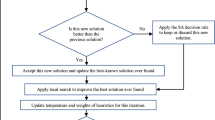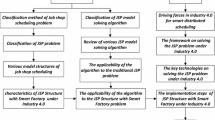Abstract
The paper proposes a two-level scheduling structure based on time aggregation. One of the main purposes of the upper-level module is to balance the load and optimally distribute production over a medium-term time horizon. Another basic objective of this module is to help the decision maker in the choice of managerial decisions related to overtime work, subcontracting, backlogs. The main role of the lower level is to implement the upper-level decisions as efficiently as possible. The study validates feasibility, robustness and efficiency of the proposed two-level structure. Experiments on real data show that the two-level structure generates substantial improvements of the schedule, particularly by decreasing the number of late jobs.
Similar content being viewed by others
References
J. C. Billaut F. Roubellat (1996) ArticleTitleA new method for workshop real time scheduling International Journal of Production Research 35 1559–1579
G. R. Bitran A. C. Hax (1977) ArticleTitleOn the design of hierarchical production planning systems Decision Science 8 28–54
B. P. Das J. G. Rickard N. Shan S. Macchietto (2000) ArticleTitleInvestigation on integration of aggregate production planning, master production scheduling and short term production scheduling of batch process operations through a common data model Computer and Chemical Engineering 24 1625–1631
J. Erschler G. Fontan C. Merce (1986) ArticleTitleConsistency of the disaggregation process in hierarchical planning Operations Research 34 464–469
Fontan G., Hetreux G. and Merce C. (1994) Consistency of decisions in multilevel production planning: analysis and implementation, IEEE International conference on systems, man and cybernetics (SCM94), San Antonio, (USA), October 2–5
L. F. Gelders (1974) ArticleTitleCoordinating aggregate and detailed scheduling in the one machine job shop: theory Operations Research 22 46–60
A. C. Hax H. C. Meal (1975) Hierarchical integration of production planning and scheduling M. Geisler (Eds) TIMS studies in management science 1, Logistics North Holland American Elsevier New York
J. B. Lasserre (1992) ArticleTitleAn integrated model for job shop planning and scheduling Management Science 38 1201–1211
M. M. Qiu L. D. Fredendall Z. Zhu (2001) ArticleTitleApplication of hierarchical production planning in a multiproduct, multimachine environment International Journal of Production Research 39 2803–2816
C. Schneeweis (1995) ArticleTitleHierarchical structure in organizations: a conceptual framework European Journal of Operational Research 81 4–31
Tsukiyama M., Mori K. and Fukuda T. (1998) Hierarchical distributed algorithm for large scale manufacturing systems, IFAC IFORS IMACS IFIP Symposium on large scale systems theory and applications. Patras, Greece
L. F. Tung L. Lin R. Nagir (1999) ArticleTitleMultiple objective scheduling for the hierarchical control of flexible manufacturing systems. International Journal of flexible Manufacturing Systems 11 379–409
Author information
Authors and Affiliations
Corresponding author
Rights and permissions
About this article
Cite this article
Fontan, G., Merce, C., Hennet, JC. et al. Hierarchical scheduling for decision support. J Intell Manuf 16, 235–242 (2005). https://doi.org/10.1007/s10845-004-5891-9
Issue Date:
DOI: https://doi.org/10.1007/s10845-004-5891-9




